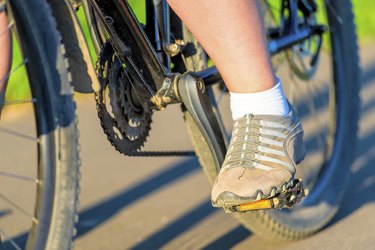
Your cycling pace is measured in two different ways. You can track your speed in miles per hour, similar to when you monitor your pace on a treadmill; for example, if you cycle at 4.0 mph, you cycle at a pace that covers 4 miles in one hour. You can also track your pace by revolutions per minute, or RPM, which tracks the number of pedal strokes you perform in each minute. For example, an RPM of 60 means that one pedal circles through a complete rotation 60 times in one minute.
Step 1
Begin riding your stationary or road bike. Adjust the resistance or gear to a comfortable workout pace. Cycle for five minutes to reach a steady state before you measure your RPM.
Video of the Day
Step 2
Maintain your steady pace and count the number of times your right foot reaches the bottom of the stroke within one minute to calculate your RPM. Look for an RPM between 60 and 100.
Step 3
Reduce your counting time and count the number of times your right foot reaches the bottom of the stroke within 15 seconds. Multiply that number by four to calculate your RPM.
Step 4
Read the computer monitor on your stationary or indoor cycling bikes as many pieces of exercise equipment calculate the RPM for you.
Step 5
Measure the RPM to correspond to your workout goals. Use an RPM of 60 to 80 when you are set at a high resistance for a hill climb. Avoid a heavy resistance that causes you to use a pace slower than 60 RPM as this causes undue stress on your knees. Use a higher RPM between 80 and 110 for a flat road or sprinting interval. Avoid RPMs over 110 as you may not be in control of your pedal stroke.
Tip
Adjust your RPM according to your fitness level. As a beginner, use a slower pace and gradually increase as your strength and endurance improve.
Warning
Speak with your doctor before you begin any exercise program.
Video of the Day